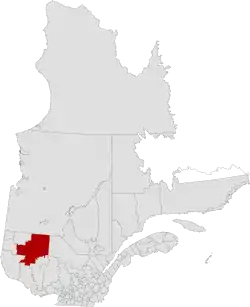La Vallée-de-l'Or | |
|---|---|
 | |
| Coordinates: 48°23′N 77°14′W / 48.383°N 77.233°W[1] | |
| Country | |
| Province | |
| Region | Abitibi-Témiscamingue |
| Effective | April 8, 1981 |
| County seat | Val-d'Or |
| Government | |
| • Type | Prefecture |
| • Prefect | Martin Ferron |
| Area | |
| • Total | 27,349.47 km2 (10,559.69 sq mi) |
| • Land | 24,094.84 km2 (9,303.07 sq mi) |
| Population (2021)[3] | |
| • Total | 43,347 |
| • Density | 1.8/km2 (5/sq mi) |
| • Change (2016-21) | |
| • Dwellings | 20,944 |
| Time zone | UTC−5 (EST) |
| • Summer (DST) | UTC−4 (EDT) |
| Area code | 819 |
| Website | mrcvo |
La Vallée-de-l'Or is a regional county municipality in the Abitibi-Témiscamingue region in Northwestern Quebec, Canada. The seat is in Val-d'Or. It is named for its gold deposits in the Harricana River and Bell River valleys.
History
Originally part of Abitibi RCM, it was created in April 1981 as Vallée-de-l'Or Regional County Municipality. The name, adjusted to La Vallée-de-l'Or on October 11, 2003, means "The Valley of Gold" and refers to the area at the sources of the Harricana River where the Abitibi gold rush took place in the 1930s.[1][4]
Subdivisions
There are 10 subdivisions within the RCM:[2]
|
|
|
|
|
Demographics
Population
Canada census – La Vallée-de-l'Or community profile
| 2021 | 2016 | 2011 | |
|---|---|---|---|
| Population | 43,347 (+0.3% from 2016) | 43,226 (+0.8% from 2011) | 42,896 (+2.4% from 2006) |
| Land area | 24,094.84 km2 (9,303.07 sq mi) | 24,292.04 km2 (9,379.21 sq mi) | 24,294.28 km2 (9,380.07 sq mi) |
| Population density | 1.8/km2 (4.7/sq mi) | 1.8/km2 (4.7/sq mi) | 1.8/km2 (4.7/sq mi) |
| Median age | 42.8 (M: 42.4, F: 43.6) | 42.2 (M: 41.4, F: 43.2) | 41.3 (M: 40.3, F: 42.3) |
| Private dwellings | 20,944 (total) 19,648 (occupied) | 20,224 (total) 19,040 (occupied) | 19,532 (total) |
| Median household income | $73,500 | $62,540 | $53,665 |
|
| ||||||||||||||||||||||||||||||
| Source: Statistics Canada[10][3] | |||||||||||||||||||||||||||||||
Language
| Canada Census Mother Tongue - La Vallée-de-l'Or Regional County Municipality, Quebec[10] | ||||||||||||||||||
|---|---|---|---|---|---|---|---|---|---|---|---|---|---|---|---|---|---|---|
| Census | Total | French |
English |
French & English |
Other | |||||||||||||
| Year | Responses | Count | Trend | Pop % | Count | Trend | Pop % | Count | Trend | Pop % | Count | Trend | Pop % | |||||
2016 |
42,780 |
39,735 | 92.88% | 1,105 | 2.58% | 250 | 0.58% | 1,690 | 3.95% | |||||||||
2011 |
42,340 |
39,360 | 92.96% | 1,205 | 2.85% | 290 | 0.68% | 1,485 | 3.51% | |||||||||
2006 |
41,275 |
37,975 | 92.00% | 960 | 2.33% | 285 | 0.69% | 2,055 | 4.98% | |||||||||
2001 |
41,845 |
38,795 | 92.71% | 1,015 | 2.43% | 300 | 0.72% | 1,735 | 4.15% | |||||||||
1996 |
43,780 |
40,565 | n/a | 92.66% | 1,265 | n/a | 2.89% | 355 | n/a | 0.81% | 1,595 | n/a | 3.64% | |||||
Transportation
Access Routes
Highways and numbered routes that run through the municipality, including external routes that start or finish at the county border:[11]
See also
References
- 1 2 "Banque de noms de lieux du Québec: Reference number 376772". toponymie.gouv.qc.ca (in French). Commission de toponymie du Québec.
- 1 2 3 "Répertoire des municipalités: Geographic code 890". www.mamh.gouv.qc.ca (in French). Ministère des Affaires municipales et de l'Habitation.
- 1 2 3 "La Vallée-de-l'Or, Municipalité régionale de comté (MRC) Quebec, Census Profile, 2021 Census of Population". www12.statcan.gc.ca. Government of Canada - Statistics Canada. Retrieved 31 October 2023.
- ↑ "Regroupements de municipalités réalisés entre le 1er janvier 2001 et le 31 décembre 2011" (PDF) (in French). Government of Quebec. February 2012. p. 21. Retrieved March 29, 2012.
- ↑ "2021 Community Profiles". 2021 Canadian Census. Statistics Canada. February 4, 2022. Retrieved 2023-10-19.
- ↑ "2016 Community Profiles". 2016 Canadian Census. Statistics Canada. August 12, 2021. Retrieved 2019-12-02.
- ↑ "2011 Community Profiles". 2011 Canadian Census. Statistics Canada. March 21, 2019. Retrieved 2014-02-22.
- ↑ "2006 Community Profiles". 2006 Canadian Census. Statistics Canada. August 20, 2019.
- ↑ "2001 Community Profiles". 2001 Canadian Census. Statistics Canada. July 18, 2021.
- 1 2 1996, 2001, 2006, 2011 census
- ↑ Official Transport Quebec Road Map
External links
Wikimedia Commons has media related to La Vallée-de-l'Or Regional County Municipality.
This article is issued from Wikipedia. The text is licensed under Creative Commons - Attribution - Sharealike. Additional terms may apply for the media files.